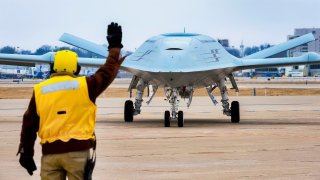MQ-25 Stingray: The Drone the Navy Truly Needs in a China War
The MQ‑25A Stingray remains a crucial step in the U.S. Navy meeting its goal of having 60 percent of its CVN air wings unmanned by 2040, the report stated.
MQ-25 Stingray, An Explainer - Aerospace giant Boeing has touted the features of its MQ-25 Stingray, which has been described as the world's first operational, carrier-based unmanned aircraft that can provide aerial refueling as well as intelligence, surveillance and reconnaissance (ISR) capabilities that enhance capability and versatility for the Carrier Air Wing (CVW) and Carrier Strike Group (CSG) – including deployed Boeing F/A-18 Super Hornet, Boeing EA-18G Growler, and Lockheed Martin F-35C fighters.
The unmanned aerial system (UAS) will be able to operate as a persistent, sea-based tanker, allowing a CVW to make better use of its combat strike fighters and extend the range of the U.S. Navy's aircraft carriers. The system has further been described as being a critical component of the future CVW and is central to the service's strategic Unmanned Campaign Framework, where it could lay the foundation for all future carrier-based unmanned systems while pioneering the cutting-edge manned-unmanned teaming (MUM-T) operational concept.
Current U.S. Navy plans call for all Nimitz-class and Gerald R. Ford-class carriers to eventually be MQ-25 capable.
"The MQ-25 brings the right combination of refueling, autonomy, and seamless carrier deck integration to meet the U.S. Navy's goals," Boeing stated.
Boeing won a $805 million development contract to build four MQ-25 carrier-based unmanned aerial tankers in 2018, beating out competing designs from General Atomics in San Diego and the Northrop Grumman Corp. Aeronautics Systems segment in Palmdale, Calif.
The system is based on the Aitech Ai-RIO avionics remote interface, which can allow as many as eight units to be networked together.
MQ-25: Flight Deck Test
In 2021 the MQ-25 T1 test asset was successfully integrated into the carrier environment during a demonstration aboard the USS George H.W. Bush (CVN-77), which served to confirm the functionality, capability and handling qualities of the unmanned aircraft's deck handling system.
"The MQ-25 will be the first unmanned platform to operate from the flight decks of U.S. aircraft carriers, as well as take on the responsibility of refueling other platforms within their designated air wing," noted the U.S. Strategic Command in a release from October 2022. "This refueling capability alone will free the F/A-18 Hornet to focus solely on its strike fighter mission set, and pave the way for future unmanned platforms' integration into the carrier air wing."
The Boeing-owned MQ-25 T1 test asset served as a predecessor to the engineering development model aircraft being produced under a 2018 contract award. The prototype T1 has been employed for early learning and discovery, laying the foundation for moving rapidly into the development and testing of the MQ-25.

Following its first flight in 2019, the T1 has accumulated approximately 125 hours in the air, helping to accelerate the team's understanding of the aircraft's aerodynamic performance and informing design decisions for both the air vehicle and its software. In its tests, the MQ-25 T1 refueled three carrier-based aircraft – an F/A-18 Super Hornet, E-2D Hawkeye and F-35C Lightning II – and became the first unmanned aircraft in history to refuel another aircraft.
The refueling drone has a total length of 51 feet, and a wingspan of 75 feet unfolded/31.3 feet folded. It is powered by a Rolls-Royce AE3700N engine, which provides a range of 500 nautical miles (580 miles) while carrying approximately 16,000 pounds (7,250 kg) of fuel.
While refueling is its primary mission, the Stingray is equipped with two under-wing stations. Though it is far less stealthy than flying wing UAVs, it does feature a stealthy fuselage shaping, flush inlet to shield engine blades from radar, and a V-tail.
Not So Fast for the Stingray and the Navy
Earlier this month, the U.S. Navy announced that it had pushed back its timeline for the adoption of the MQ-25 Stingray according to a new report released by the Department of Defense's (DoD's) Office of Inspector General.
Published on November 16, the report warned that making critical production decisions without development tests and evaluation could increase the risk that the program will not meet operational capability requirements, while it could face delays to its deployment on U.S. Navy aircraft carriers. Production costs may also rise.
"If the MQ‑25 program operates as expected, it will provide critical support for the National Defense Strategy by extending the operating range of the CVNs' air wings and reducing the aerial refueling burden on F/A‑18s, which will save costs and improve readiness. However, making critical production decisions without conducting sufficient testing introduces additional risk that the MQ‑25 program will not meet its operational capability requirements, which could require costly and time‑consuming engineering changes and may delay the MQ‑25A's deployment," the IG report noted.
The Q‑25A Stingray remains a crucial step in the U.S. Navy meeting its goal of having 60 percent of its CVN air wings unmanned by 2040, the report stated.
"Therefore, the chief of naval operations stated that it was critically important to deploy the MQ‑25A on CVNs as quickly as possible," it added.
Author Experience and Expertise
Peter Suciu is a Michigan-based writer. He has contributed to more than four dozen magazines, newspapers, and websites with over 3,200 published pieces over a twenty-year career in journalism. He regularly writes about military hardware, firearms history, cybersecurity, politics, and international affairs. Peter is also a Contributing Writer for Forbes and Clearance Jobs. You can follow him on Twitter: @PeterSuciu.


